Disclosing Australian Newspaper's Ideologies in Reporting Political News through Social Actor Representations Strategy
CDA Perspective
DOI:
https://doi.org/10.15642/NOBEL.2020.11.1.38-54Keywords:
CDA, ideologies, newspaper, Social actors, Papua, conflictAbstract
This research aims at explaining how and why the Sydney Morning Herald communicates its ideologies in such a way through the social actors represented in news reports. Using Fairclough’s and Van Dijk’s model of CDA and Theo Van Leeuwen’s framework of the representation of social actors, the study found that in terms of assimilation, nomination and categorization, functionalization and identification, and Impersonalization, the newspaper viewed the Indonesian government, army, and military officers as the Out group social actors, and Australian, Papuan activists and those who support Papuan conflict as the In group social actors. These categorizations serve different purposes. Those who are related to the Out groups express a purpose to emphasize their brutality, superiority, and dominance towards the indigenous Papuans. On the other hand, In groups social actors were indicated as peacemakers. These findings signaled Australia’s political ideologies and hidden purposes towards Indonesia. Australia views itself as a liberal country which respects individual freedom; therefore, the government must protect and get justice, and, it is also Australia’s responsibility to give aids to Papuans who are seeking better place as stated in the international law which gives a picture of how this country is concerned towards Indonesia
Downloads
References
Asmaradhani, A.I. (2019). Enemy construction in the declaration of war against Japanese empire: CDA perspective. Nobel Journal of Literature and Language Teaching.10 (2).117-130. DOI: 10.15642/NOBEL.2019.10.10.2.117-130
Bell, A. (1991). The language of news media. London & New York: Blackwell.
Bloor, M. & Bloor, T. (2007). The practice of critical discourse analysis: An introduction. London: Hodder
Burchill, S. & Kingsbury, D. (2001-12). Australia and Indonesia: Beyond stability towards order. Canberra Buletion of Public Administration.102. (67-73).
Caldas-Coulthard, C. R. (2003). Cross cultural representation of ‘otherness’ in media discourse in G Weiss and R. Wodak (eds). Critical discourse analysis: Theory & interdisciplinary (pp.272-296). New York: Palgrave.
Crosby, L. Modern Australia – The Challenge of Nation Building. (2002). The federal platform of the liberal party of Australia. Retrieved on 23 May, 2014 in www.liberal.org.au/info/docs/federalplatform.pdf.
Fairclough, N. (1989). Language and power: Discourse and power. London: Longman.
Fowler, R. (1991). Language in the news: Discourse and ideology in press. London & New York: Routledge.
Fowler, R. (1996). “On critical linguistics.” Caldas-Coulthard, CR & Coulthard, M. (ed). Texts and practices: Readings in critical discourse analysis (p; 3-14). London: Routledge.
Ghannam, N. (2011). Newspaper ideology: A critical discourse analysis of an event published in six Lebanese newspapers [Thesis]. University of the Witwatersrand, South Africa.
Hirst, A. (2002). The federal platform of the liberal party of Australia. Retrieved on February 2020 in https://cdn.liberal.org.au/pdf/FederalPlatform.pdf
Kegan, P & May, B. (1978). The Indonesian tragedy. London: Routledge.
Liao, N. (2012). Ideology in newspaper reporting: A cross cultural analysis of transitivity choices [Unpublished Thesis]. San Diego State University.
Naghty, E. C. (2010). Directing ideologies through media cartoons [Unpublished Thesis]. Universidad Computense de Madrid.
Rashidi, N. & Rasti, A. (2012). Doing (in) justice to Iran’s nuke activities? A critical discourse analysis of news reports of four western quality newspapers. American Journal of Linguistics, 1(10). 1-9
Richardson, J. E. (2007). Analysing newspapers: An approach from critical discourse analysis. New York: Palgrave Macmillan.
Surjowati, R. (2015) Newspaper ideology: Critical discourse analysis on 2002 Bali bombing and Papua conflict reported by Sydney Morning Herald. In: International Seminar “Language Maintenance and Shift” V ISSN; 2088-6799, 2-3 September 2015, Hotel NEO Semarang.
Van Dijk, T. A. (1998). Ideology: A multidisciplinary approach. London: Longman.
Van Dijk, T. A. (2000). Ideology and discourse: A multidisciplinary introduction. Retrieved on February, 20, 2020. In http://www.discourses.org/UnpublishedArticles/Ideology%20and%20discourse.pdf.
Van Dijk, T. A. (2006). Ideology and discourse analysis. Journal of Political Ideologies. 11(2), 115-140. Retrieved on February, 19, 2020. in https:// www.tanfondline.com/doi/abs/10.1080/13569310600687908
Van Dijk, T. A. (2009). Discourse studies: A multidisciplinary introduction. 2ed. London: Sage
Van Dijk, T. A. (2012). Discourse analysis as ideology analysis. Retrieved on March, 2012 in http://www.discourse.org/OldArticles/Discourse%20%20ideology%20analys.pdf.
Van Leeuwen, T. (1996). The representation of social actors. In Caldas-Coulthard, C.R & Coulthard, M. Eds. Texts and practices: Readings in critical discourse analysis. (pp 32-70). London & New York: Routledge.
Van Leeuwen, T. (2008). Discourse and practice: New tools for critical discourse analysis. New York: Oxford University Press.
Vo, DD. (2011). Style, structure and ideology in English and Vietnamese business hard news reporting: A comparative study [Dissertation]. University of Adelaide.
Willoughby, J.R (1960). The official federal platform of the liberal party of Australia. Retrieved on February, 22, 2020 from https://parlinfo.aph.gov.au/parlInfo/download/library/partypol/1193431/upload_binary/1193431.pdf;fileType=application%2Fpdf#search=%22library/partypol/1193431%22
Wodak, R and Meyer, M. (2006). Methods of discourse analysis. London: Sage Publication.







